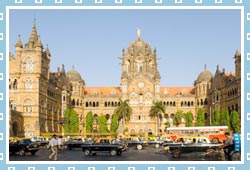 |
History
The Chhatrapati Shivaji station, formerly known as Victoria Terminus, was built in 1888. Designed by the British architect F.W. Stevens, the structure became a symbol of Bombay (Mumbai) and the city was labeled the 'Gothic City' due to this magnificent building's architectural styles. Apart from being the hub for major mercantile activities, the CST is the perfect amalgam of British and Indian designs. In the past, 'Bori Bandar' station, located along the Eastern parts of Mumbai, was the place for commercial exchanges and trading activities. In the 1850's, the Great Indian Peninsular Railway operated in this area and gave it the name 'Bori Bandar', starting its first rail service, covering a total distance of 34 km to Thane.
During the British rule, the station was eventually redesigned and rebuilt by F.W. Stevens, who named it as Victoria Terminus. The station got its name from the then reigning royal, Queen Victoria. The construction of the station took 10 years to complete and was opened to the Queen on the date of her Golden Jubilee in 1887. At the time, the building was the most expensive structure in Mumbai costing 260,000 Sterling Pounds. The station was built to handle main rail traffic and in 1929, a new station and an administrative headquarters were built by the Central Railway. In 1996, the Minister of Railways, Suresh Kalmadi, changed the name of the station to Chhatrapati Shivaji Terminus (CST).
Architecture
The main architecture of the building reflects the Victorian Gothic styles and designs of the late 19th century. The style and the ornamentation of the edifice were acceptable to both Indian and European culture. Complete with turrets, pointed arches and an eccentric ground plan, the CST was a novel achievement during that period. To date, the building retains most of the architectural designs with probably, an addition of two or more headquarters. The CST was built in accordance to a C-shaped plan, symmetrical on both, the east and the west axis. Crowned by a high dome, which is the focal point of the structure, the CST building is adjoined with well-proportioned rows of arched structures, rows and windows, closely resembling Indian palace architectures.
The entrance of the Chhatrapati Shivaji terminus is flanked by figures of a lion and a tiger representing the two countries-great Britain and India. The main structure is made of sandstone and limestone, and the interiors of the station are lined with high-quality Italian marble. Apart from the 18 railway lines, the CST also houses the main headquarters, the Star Chamber, grotesques and the North Wing.
Nearby Tourist Attractions